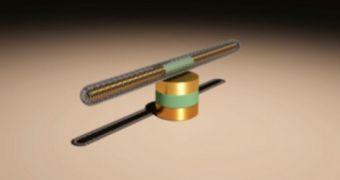This past May 20, scientists with the University of Texas at Austin in the United States announced the development of a motor that they say is so small that it can easily fit inside the average human cell.
In a paper published in a recent issue of the journal Nature Communications, the specialists detail that this so-called nanomotor is about 500 times smaller than a grain of salt.
The motor works by converting electrical energy into mechanical motion and can spin at about 18,000 revolutions per minute (RPMs, for short).
What's more, the specialists who developed it claim that the nanomotor can keep rotating for up to 15 hours without ever asking for a coffee or a bathroom break, and it spins both clockwise and counterclockwise.
To put things into perspective, it need be said that, although nanomotors were developed before, their rotation speed was one of just 14 to 500 revolutions per minute.
Besides, these other nanomotors were only able to keep up and running for a few seconds at a time. The best of them did hold on for a few minutes, but none of them managed to function for several hours in a row.
As detailed on the official website for the University of Texas at Austin, such nanomotors could one day serve to power very small devices that can move through the body of one individual or another with great ease and administer various drugs.
Specifically, it is argued that devices based on motors like the one pieced together by the University of Texas scientists might one day administer insulin to diabetics, maybe even help treat cancer by delivering drugs to affected cells.
In fact, experiments have shown that, when coated with biochemical, the nanomotor developed as part of this research project managed to deliver varying quantities of drugs depending on its rotation speed.
“We were able to establish and control the molecule release rate by mechanical rotation, which means our nanomotor is the first of its kind for controlling the release of drugs from the surface of nanoparticles.”
“We believe it will help advance the study of drug delivery and cell-to-cell communications,” mechanical engineering professor Donglei Fan said in a statement.
The University of Texas at Austin plan to continue their work and hope that it will not be long until they manage to test how their nanomotor behaves when put to work in the proximity of an actual and live human cell.
Check out the video below to learn more about this project.

 14 DAY TRIAL //
14 DAY TRIAL // 